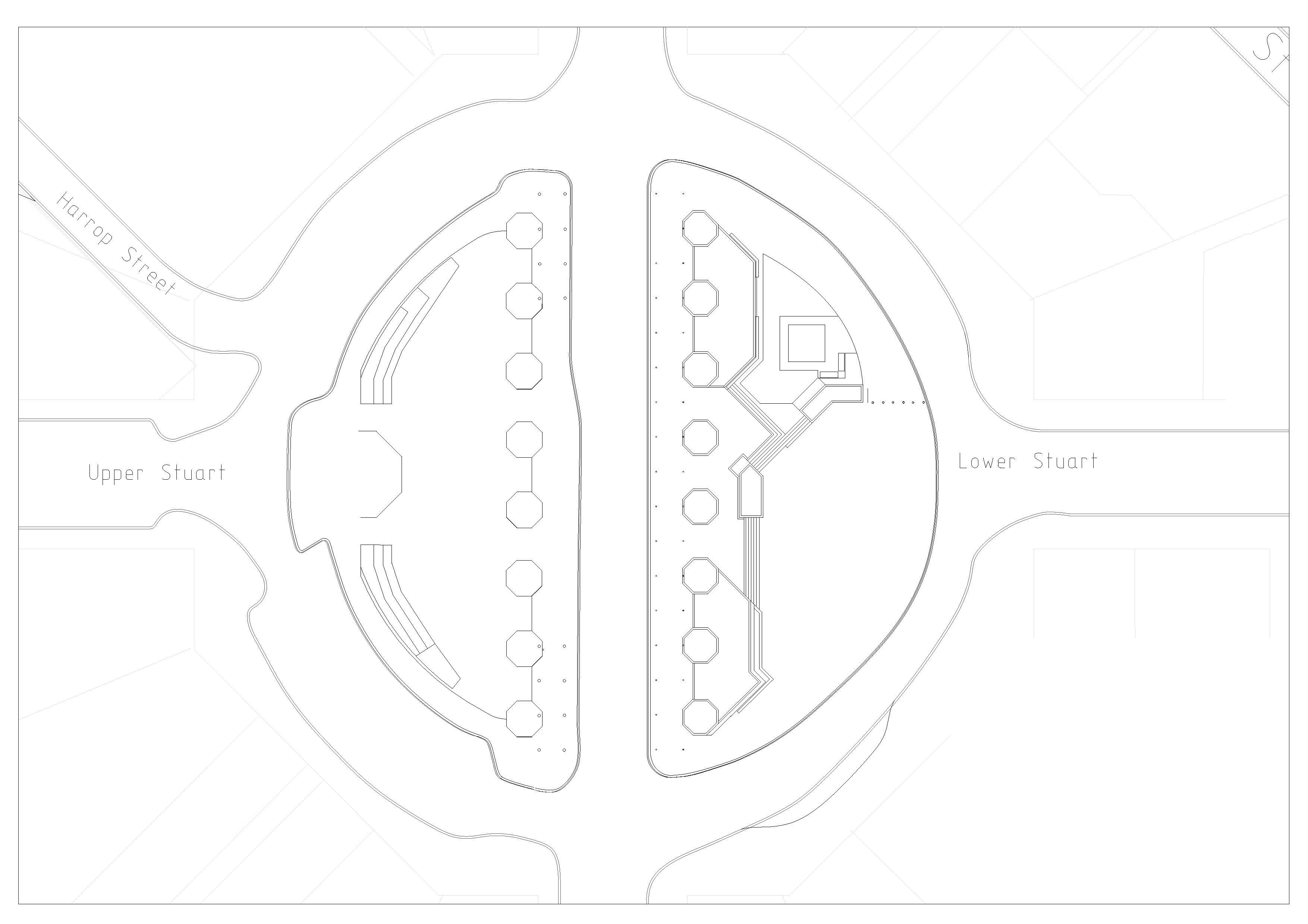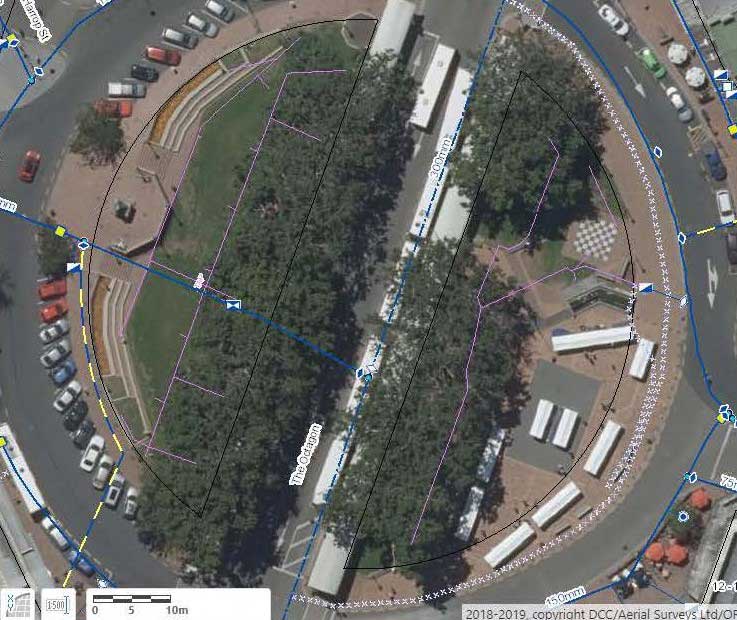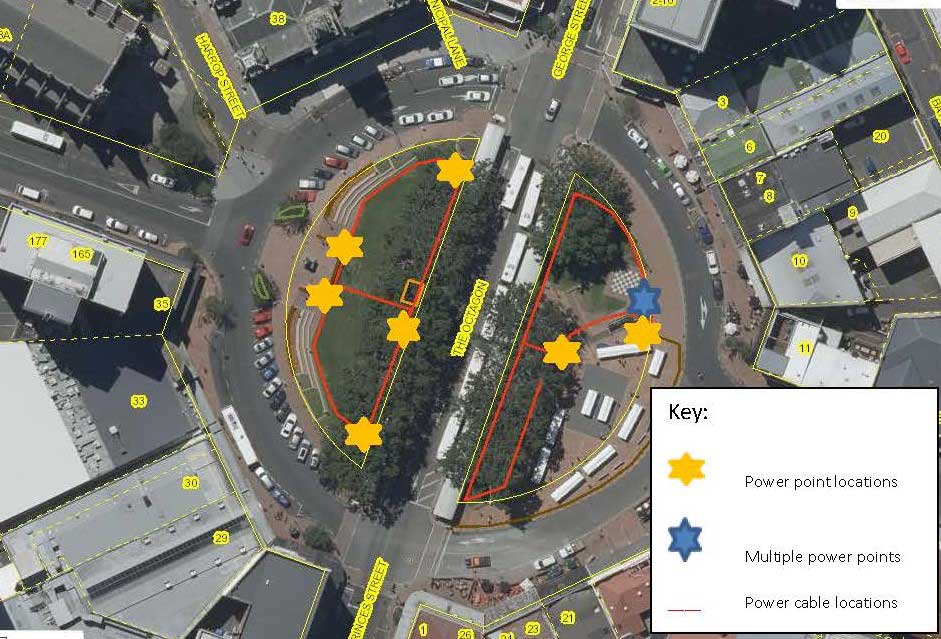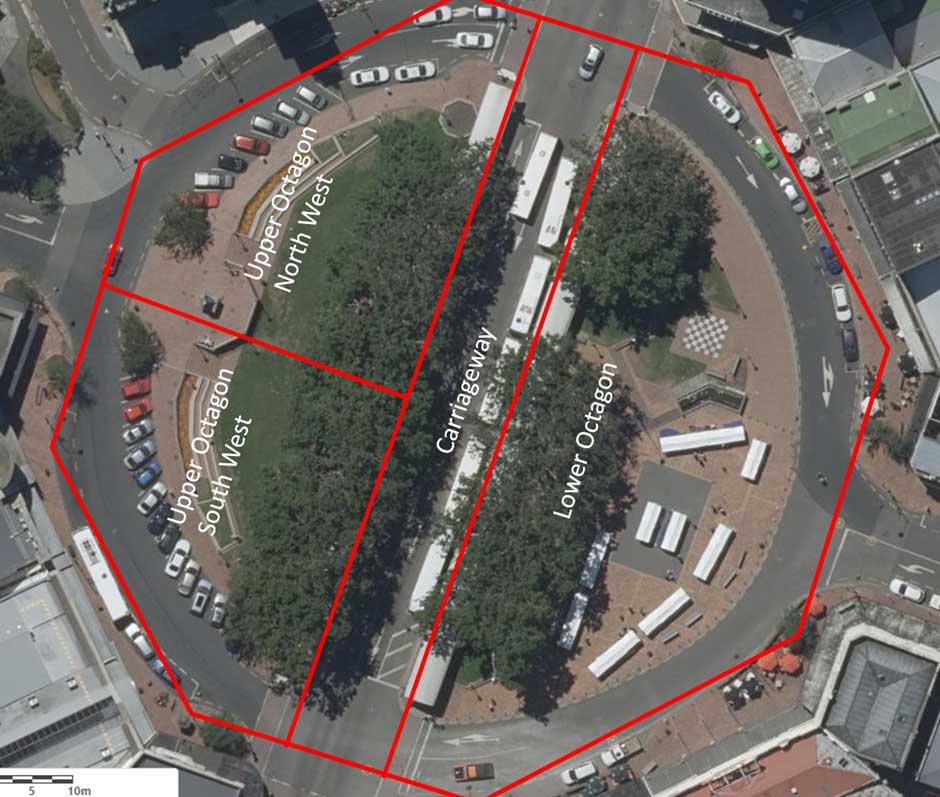The Octagon is a popular area to hold events due to its size and location in the central city and is owned and managed by the Dunedin City Council (DCC).
The information below aims to guide and advise event organisers when planning events in the Octagon.
There are many points to consider including traffic management and road closures, health and safety, hazards, the cruise ship season, resource and building consents, facilities and services, waste minimisation and liquor restrictions.
-
Areas of the Octagon
The Octagon is separated into sections – full Octagon, upper, lower and barbecue areas (see map below). The carriageway is also bookable, but a traffic management plan (TMP) is required to close this space to traffic. To book any area of the Octagon for your event, please visit our online booking system.
-
Upper Octagon
This includes the grass area, band rotunda and the Robbie Burns statue. It is managed by Parks and Recreation Services (PARS) as it is considered a reserve.
-
Carriageway
A traffic management plan (TMP) is required to close the road if you want to use the carriageway for an event. For further information see the section below on traffic management and road closures and
-
Lower Octagon
The lower Octagon is managed by Parks and Recreation Services (PARS) as it is considered a reserve, but the road and footpaths are managed by the Transport Department. There is a small fee if event organisers require the bollards to be lowered for pack in and pack out. For information on the water features in the Lower Octagon see the fountains and access to water section below.
Site plans
-
Full Octagon plan

-
Irrigation plan

The blue lines indicate the water mains and the purple lines are the irrigation systems in the upper and lower Octagon. The white crosses are the old underground water system that serviced the Star water feature.
-
Cable and power location for upper and lower Octagon

-
Health and safety and traffic management
Under the Health and Safety at Work Act 2015, the event organiser is legally responsible for ensuring the health and safety of event staff, participants, spectators, contractors, subcontractors and event staff working within the event site.
To get approval for your event to be held on Council-owned land, your health and safety plan must demonstrate you have considered health and safety in detail during your event planning.
If working over 1.5m in height, approved contractors will be required to perform this work. Certification will also need to be seen and included in the health and safety plan.
See the link below for more information, including ensuring there is a provision for first aid.
-
Hazards in the Octagon
The Octagon is multi levelled and comprised of surfaces that include grassed and bricked areas, stairs, water features, roads and footpaths. Many businesses operate in the Octagon. These factors need to be considered and included in your health and safety plan/risk management register.
-
Emergency evacuation plan
In case of an emergency requiring evacuation of your event, the following responses are required:
- Entertainment will cease
- A warning will sound via the public address system instructing personnel and the public to relocate by the safest route to a safe assembly point.
- For isolated incidents in the lower Octagon, people should evacuate to the carriageway and upper Octagon (see map below)
- For isolated incidents in the carriageway, people should evacuate to the upper Octagon
- For isolated incidents in the upper Octagon, south west, people should evacuate to the carriageway and the upper Octagon, north west.
- For isolated incidents in the upper Octagon, north west, people should evacuate to the carriageway and the upper Octagon, south west.
If the emergency is due to an earthquake, structural collapse, tsunami, explosion or aviation incident, the following responses are required:
- Entertainment will cease
- A warning will sound via the public address system instructing personnel and the public to relocate by the safest route to a safe assembly point.
- The centre carriageway is the centre-most point from tall structures
- The safest route exiting the Octagon, if clear, is Upper Stuart Street
- Staff and security need to be aware that the natural panic response is to go down.
If the emergency is due to shooting or terrorism the following responses are required:
- Entertainment will cease
- A warning will sound via the public address system instructing personnel and the public to relocate by the safest route to a safe assembly point.
- Run, hide, tell
- Exit the safest direction away from the incident
- Do not return to the area until the all clear has been given.

-
Civil defence
- Keep the young and elderly safe
- Civil defence will take about 20 minutes to activate
- Await instructions and play the radio through the sound system
- When calling 111, read the following to the dispatcher:
- We have an emergency at …
- We need help from ambulance/fire/police …
- Directions to the emergency are …
- My phone number is ….
- The medical problem seems to be ….
- Send someone to meet the emergency services.
-
Traffic management and road closures for events
If your event will affect use of a road or footpath or you intend to place anything on or above the carriageway, you will need a traffic management plan (TMP) drawn up by a qualified traffic controller and approved by the DCC Transport Department. Think about the safety of your event and those attending. Will you have activities on the road, such as food trucks, or restrict parking in the event area?
All road closures for events (including car rallies) must be approved at a Council meeting.
This means event organisers must submit their Traffic Management Plan to DCC Transport, via their chosen traffic management contractor, no later than three months before their proposed road closure date. A copy of the signed affected parties consent form, or copies of correspondence to affected parties, must be included with the TMP.
The road closure will be publicly advertised by DCC Transport before the Council meeting, allowing time for objections to be lodged. A report is then provided to the Council meeting for approval.
When preparing your TMP with your traffic management contractor, include postponement dates in your TMP as Dunedin weather is unpredictable. Having a postponement date approved at the Council meeting allows flexibility if you need to make a late change.
For those events that are not closing a road but are altering how the road normally operates e.g. reducing the speed, approval at a Council meeting is not required. A TMP must still be submitted to DCC Transport six weeks before the event date.
For more information or advice on traffic management for your event, please contact the Events team at events@dcc.govt.nz or see Traffic Management at Events
-
Cruise ship season (October – April)
When the Octagon is closed due to an event which coincides with days when cruise ships are in port, cruise ship shuttles arrive at and leave from the Toitū Otago Settlers Museum instead of the carriageway.
The Events team will work with event organisers to confirm details and extra costs associated with cruise ship shuttles if required.
-
Harrop Street
The Town Hall has a permanent TMP in place and can close Harrop Street when required. Dunedin Venues Management Ltd (the Dunedin Centre) have control over Harrop St, but if you wish to include Harrop Street in your TMP, please discuss this with your TMP contractor.
Consents and licencing
-
Resource consents
The DCC has statutory responsibilities under the Resource Management Act 1991 and is tasked with promoting sustainable management of the natural and built environment through a range of tools, including land use planning. We encourage you to discuss your event and your event needs with our Planning team at planning@dcc.govt.nz to determine if you require resource consent for your event to proceed. Consent may be required, depending on the following factors:
- If it exceeds permitted noise limits
- The duration (including set up and pack down)
- The number of people in attendance
- Changing existing use of the site identified for the event.
Resource consents can take up to six months to process, depending on the event, so it’s important to apply early.
-
Building consents
The building consent process is designed to ensure all buildings and structures comply with the Building Act 2004. Building consents will be required if you wish to erect a marquee over and above 10m x 10m. Your marquee provider will also be able to help determine this. Staging and some fencing will also require building consents or an exemption can be requested. The building consent process can also take several months, so it’s important to apply early.
-
Mobile trading, food trucks and temporary food stalls
The Food Act 2014 requires businesses selling food to be registered and verified to ensure food is being prepared in a safe and suitable manner. As an event organiser, you’re responsible for ensuring all stalls selling food hold the correct approvals where necessary. It’s important that you understand what is required from each type of operator attending your event.
Before your event, please provide DCC Environmental Health with a list of food stalls, including mobile traders and fundraisers.
For more information, fact sheets and applications forms visit Food for sale
Under the Trading in Public Places Bylaw 2020 you need to obtain a concession licence from Parks and Recreation Services (PARS) to operate a mobile business (including food trucks) on a park or reserve, for example, the lower Octagon. For more information and application forms visit Mobile trading
-
Liquor restrictions
A general liquor ban exists for the Octagon and CBD area, under the DCC Alcohol (Control of Alcohol in Public Places) Bylaw 2004, but bars and restaurants can apply for special licences to extend onto the footpath for special events when the lower Octagon and Lower Stuart Street are closed to vehicles. For special licence applications, see the District Licencing Committee and the Dunedin Local Alcohol Policy
Charges apply for special licences and allow 20 working days for processing.
-
Busking
You must have a street performing permit to busk in Dunedin. There is no charge for a street performing permit, but there are some conditions. These conditions are to make sure everyone enjoys our public spaces and are listed in the conditions for street performing.
When organised events are held, street performers must be a least 500m away unless they have been invited to perform at the event.
A permit is not required for anyone performing as part of an organised event.
Facilities and services
-
Access to power
Single-phase and three-phase power is available in the Octagon but three-phase power is only available in the lower Octagon. See site maps below for locations. If an event requires access to power and, once the booking has been approved, the key can be collected from Customer Services on the ground floor of the Civic Centre. The bookings coordinator from PARS will liaise with the event organiser to determine whether single-phase or three-phase power is required and arrange collection of the key. The key can be returned to the DCC between 8.30am and 5pm from Monday to Friday.
-
Municipal Lane toilets
For large community events, requests to extend opening hours of the Municipal Lane toilets can be made to the DCC’s Property Department and extra cleaning services may be arranged, depending on the event.
-
Fountains and access to water
The fountains in the lower Octagon can be turned off when requested. There may be a charge for this service.
There is also a drinking water fountain next to the Robbie Burns statue. This is only turned off during extreme cold weather to prevent the pipes from bursting.
-
Waste minimisation and management
We encourage Dunedin event organisers to reduce waste and increase recycling and re-use of materials during events.
Pre-planning around waste reduction and minimisation could help your event achieve its goals and save costs. Take time to develop an understanding of the waste your event is likely to generate and your waste reduction aims are.
Waste Minimisation and Management at Events in Dunedin guides event organisers on minimising and managing the waste an event may generate and how to send less to the landfill.
You may opt to apply to use the DCC’s event bin kit which includes recycling, glass and rubbish bins.
Contact the DCC Waste and Environmental Solutions team if you wish to discuss ways to minimise or dispose of waste at your event.
-
Trees and gardens
No lighting or installations are to be installed in or on trees in the Octagon, nor can they be placed in the planted areas on either side of the Robbie Burns statue. Up-lighting on the ground around the statue is permitted at the event organiser’s expense.
-
Animal control
Dogs are prohibited at all times in the Octagon (Clause 5.8). A fine of $300 for breaching this may be imposed, however, this does not apply to working or disability assist dogs (Clause 5.6.1).
-
Art installation
The public chessboard that had previously occupied the space in the lower Octagon since 1993 has been replaced by Ayesha Green’s Kō te Tūhono sculpture. Ms Green has described Kō te Tūhono as a “gateway connecting us with our deep ancestral ecologies”.
Organisers of events in the Octagon should work around the sculpture in the same way they do with the trees, fountains, steps and other built structures. Care should be taken not to knock or scratch the sculpture when shifting equipment nearby. Nothing should be fastened to the artwork e.g. guy ropes, banners or flags.
-
Fireworks and projections
For information regarding fireworks and light/visual projections see Fireworks and Projections at Events
